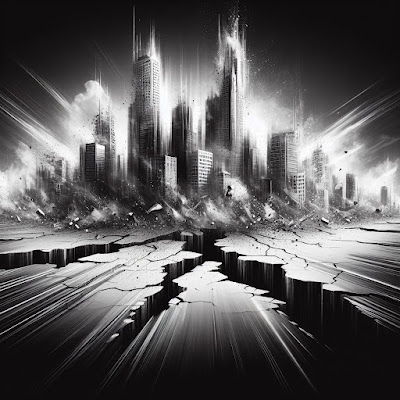The Earth is a dynamic planet, and one of the ways this dynamism manifests itself is through earthquakes. These sudden and often violent tremors can cause widespread damage and loss of life. But what exactly causes these ground-shaking events?
The Theory of Plate Tectonics
The Earth's surface is made up of a patchwork of tectonic plates that float on the molten rock of the mantle. These plates are constantly moving, albeit very slowly, in response to the forces of convection within the mantle. When two plates meet, they can either slide past each other, collide and crumple, or diverge. It is at these plate boundaries that most earthquakes occur.
Friction and Release
As two plates grind against each other, friction builds up along the boundary. This friction can eventually become too much to overcome, and the plates will suddenly slip past each other. This sudden release of energy is what causes an earthquake.
The Anatomy of an Earthquake
The point below the Earth's surface where the slip occurs is called the hypocenter. The point directly above the hypocenter on the Earth's surface is called the epicenter. The energy released from the hypocenter travels outward in all directions as seismic waves. These waves are what cause the ground to shake.
The Different Types of Earthquakes
There are two main types of earthquakes: shallow earthquakes and deep earthquakes. Shallow earthquakes occur within 60 kilometers of the Earth's surface. These are the earthquakes that are most likely to cause damage. Deep earthquakes occur between 60 and 660 kilometers below the Earth's surface. These earthquakes are less likely to cause damage, but they can still be felt over a wide area.
The Impact of Earthquakes
Earthquakes can have a devastating impact on both people and property. They can cause buildings to collapse, roads to crack, and fires to break out. In addition to the immediate damage, earthquakes can also trigger other natural disasters, such as landslides and tsunamis.
Predicting Earthquakes
Unfortunately, we are not yet able to predict earthquakes with certainty. However, scientists are constantly working to improve our understanding of these events. By studying past earthquakes and monitoring the movement of tectonic plates, we may one day be able to give people more warning before an earthquake strikes.
In conclusion, earthquakes are a natural phenomenon that is caused by the movement of tectonic plates. While we cannot yet predict earthquakes with certainty, scientists are constantly working to improve our understanding of these events. By learning more about earthquakes, we can better prepare for the next time one strikes.
I hope this blog has given you a better understanding of how earthquakes happen. If you have any questions, please feel free to leave a comment below.
Stellar dynamics is that the branch of uranology that describes in an exceedingly applied mathematics means the collective motions of stars subject to their mutual gravity. The essential distinction from uranology is that every star contributes a lot of or less equally to the overall field of force, whereas in uranology the pull of a vast body dominates any satellite orbits. Historically, the ways used in stellar dynamics originated from the fields of each mechanics and physics. In essence, the elemental drawback of stellar dynamics is that the N-body drawback, wherever the N members ask the members of a given stellar system. Given the big variety of objects in an exceedingly stellar system, stellar dynamics is sometimes involved with the a lot of international, applied mathematics properties of many orbits instead of with the particular knowledge on the positions and velocities of individual orbits. The motions of stars in an exceedingly ga...




Comments
Post a Comment